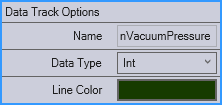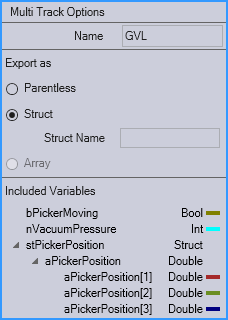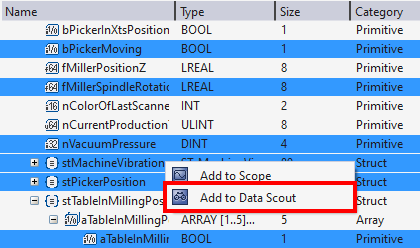Tracks
Tracks are elements of the Data Tracks Editor, which contain information about the contained data and the structure of the symbolism.
Presentation

The area provided for tracks in the Data Track Editor has the following elements:
| This button opens a new Track Editor Export window. |
| Clicking on it opens a popup where settings for the display of the tracks can be made. |
| Clicking on it opens a popup where settings for the timeline and Time Tracks can be made. |
| The blue area lies above the tracks and represents which data is displayed in the chart. Also, the selected area is used for some toolbar functions. The red and green areas can be moved to increase or decrease the selection. If clicked between the red and green area, the selected area can be moved. On the left and right edges, the selection can snap. This happens near marker and track ends. To ignore the snap function, the Alt key can be pressed while moving. The selection cannot be smaller than 10 values. |
| Markers are displayed in the track as well as in the chart. In the tracks, markers can be renamed by clicking on the text and markers can be removed by right-clicking. The markers that have no text but scissors are special markers that can be used for elimination. |
| The timeline has the start time marked at the left end. Markers then follow at even intervals, indicating the time present there. |
| At the right end of the timeline is a marker for the end time. The end time will be equal to the start time plus the number of samples from the track with the fewest samples times the cycle time. If the number of samples in the tracks differs, a red dashed area is displayed behind the end time marker. This area is not exported, because there would not be data for all tracks. |
Tracks Container | In the lower part the tracks are displayed, where the display of the data from the tracks starts at the start time and before that the new symbolism is displayed. |
Data Tracks
Currently there are two types of tracks that can contain data. The first is the Single Track. This represents a single symbol. The second is the Multi Track. This can group multiple symbols together, keeping the presentation simple. However, in Multi Tracks e.g. the data types or names of the contained symbols cannot be customized.
Tracks that contain data are displayed in a similar way.

On the left side are the following functions:
| Here you can define whether the track should be visible as a graph in the chart or not. |
Track Name | The name of the track is used in the chart for the graph and in the export as the symbol name. The name must be unique below a container and cannot contain spaces. |
| Clicking on it will open a popup. This shows the settings of the track (see the Settings section for more details). |
| This button removes the track and all the tracks under it |
On the right side the data elements of the track are displayed. Data Tracks can contain multiple data elements that match the type of track (e.g. a Single Track cannot contain an array).
Container Tracks
Container Tracks are structured similarly to Data Tracks. However, no data elements can be in Container Tracks, but they can contain tracks. Included tracks are displayed below the Container Track and can be expanded or collapsed using the  buttons. When a Container Track is made visible or invisible, all sub tracks become visible or invisible as well.
buttons. When a Container Track is made visible or invisible, all sub tracks become visible or invisible as well.
Settings
For all types of tracks there are different settings in the popup of the  button.
button.
For Single Tracks there are these:

Data type | Here you can define the data type of the Single Track. The displayed as well as the exported data will be converted to the types specified here. For string data types, another text field is displayed, which determines the length of the string. If the data type could lead to problems with the conversion, because one or more data elements of the track have a larger data type, a warning will be issued, but the values will still be converted. |
Lines color | Sets the color of the graph in the chart. When you click on it, a color picker is displayed in which you can set the color. |
For Container Track there are these settings:

Container type | A Container Track can be a structure or an array. To be created as an array, however, all sub tracks must be compatible to form an array. If only Single Tracks are available, a Container Track can be made into an array with a primitive data type. If there are only Container Tracks that have the same structure, the Container Track can be made into an array with primitive array or structure as the base data type. |
Each container type has its own properties:
Structure | Structure Name | Specifies the desired name for the data type in the export. |
Array | Base data type | Here you can set the data type for the array elements. Setting the data type here changes the array base data type of Sub Container Track and the data type of Sub Single Tracks. For string data types, the length of the string can be set. |
| Oversampling | This option is only available if the Container Track has only Single Tracks as sub tracks. When active, the sub tracks are not displayed as individual graphs in the chart, but the Container Track is displayed as one graph. For this purpose, the values of the sub tracks are loaded and all values at the same time are placed one after the other. |
For Multi Tracks there are these settings:

Export as | Similar to the container type of the Container Track, it can be set how the Multi Track should be handled in the export. For Structure, the Multi Track is exported as a structure data type with the contained variables as elements. The desired name for the structure can be specified. The option to export as array is available only if all contained variables have the same data type. The data type can then also not be changed. The Multi Track becomes an array during export with the contained variables as array elements. With Parentless, the Multi Track is not taken into account in the export and it is as if the contained variables were on the Multi Track level. |
Variables included | The symbolism present in the Multi Track is displayed here. All data elements of the Multi Track must have the same symbolism. |
Data elements
Data elements can be located in Tracks. These contain one or more variables from a source, and a time range from the source. Using the time range and the cycle time of the source, it is calculated how many samples are in the data element. The length of a data item is determined by looking at which track contains the most samples and how much space is available in total. The length then depends on the number of samples and how many pixels correspond to one sample.
A data item is represented as a block. The color of the data item depends on the source it comes from, so all data items from the same source have the same color. There is a dividing line at the end of the data element. The original name of the symbol from the source is displayed in the data element. If there are several symbols, only the number of symbols is displayed.
By right-clicking on a data element, the context menu can be opened. The data element can also be removed completely without using the functions from the toolbar.
Add via drag and drop
The tracks of a Data Track Editor are displayed in a separate area. This is empty at the beginning and can be filled using the Target Browser.

When one or more symbols are selected from the Target Browser and dragged into the empty area of the Track Editor, a new Container Track is created. To the new Container Track all selected symbols will be added as tracks.

If a symbol is dragged onto the data area of a Container Track, a new track is created below this container.

When dragging to a Data Track, a new data element can be added to that track. However, this is only possible if the symbol to be added is compatible with the track. No structure can be drawn on a track with primitive data types.

To create new Multi Tracks you can drag to a Container Track or to the empty area while the [Ctrl] key is pressed.

If structures or arrays are to be added, this can happen as with symbols with primitive data type. However, Container Tracks are created for the upper elements of structures and arrays.

Automatic merging
To more easily merge symbols with the same structure, such as in an Analytics File with multiple records, when dragging multiple symbols onto a container or the empty area of the tracks, the system checks if the symbolism is the same. As soon as this is detected, a message appears that it is possible to add the symbols to the already existing tracks.

If this query is answered with Yes, the added symbols will be appended as a data element to the matching existing track. If the query is answered with No, new tracks are added.

The same result can be achieved by dragging each symbol individually onto the already existing track.
Change order
If the order of existing tracks or data elements is to be changed, this can be done with drag and drop. Data elements can be moved on the whole surface and tracks on the left border  . To do this, the area must be clicked with the left mouse button and moved with the mouse button pressed.
. To do this, the area must be clicked with the left mouse button and moved with the mouse button pressed.
Data elements can be rearranged in the same track or moved to another track. When data elements are dragged onto container tracks or into the track editor, a new track is created. Also, the data element must be compatible with the track it is moved to e.g. a data element with multiple symbols from a multi track cannot be moved to a single track.
Tracks can be rearranged below the container they are in or moved to another container. It is not possible to move tracks into containers that are inside the track to be moved or to move tracks that cannot be changed by their configuration or the configuration of the container above them, e.g. structure arrays.
Add via Target Browser Command

It is possible to add symbols from the Target Browser to a Track Editor by calling the "Add to Data Scout" command in the context menu. The command is displayed when symbols compatible with the Track Editor are selected in the Target Browser and right-clicked. Tracks are then created for each symbol and the sub-symbols of arrays and structures.
If no Data Scout Project exists, an attempt is made to create a new one. If there is already a Data Scout Project in the current Solution, the symbols will be added there. If a Track Editor is selected in the Solution Explorer, the symbols are inserted into it, otherwise a new one is created.








